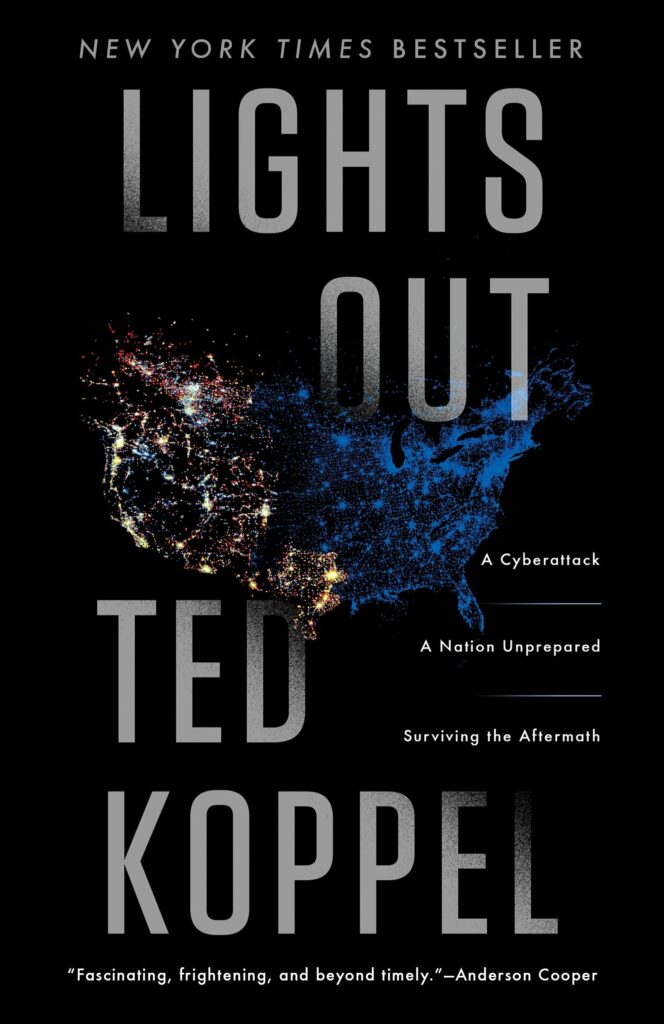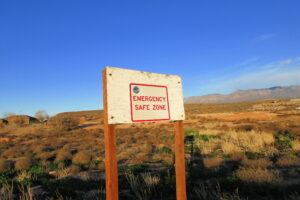
by Ted Koppel (Edward J. Koppel), 2015
A well-written and easy-to-read warning about our vulnerability and lack of preparedness for a cyber-attack on our electrical grid. My three main take-aways are 1. The Mormons are the pros in disaster-preparedness; 2. The Red Cross is more concerned with appearances and fund-raising and uses disasters to further both; and 3. There are mini nuclear reactors that don’t require much lead time or regulation and could power whole military bases, so why not small towns, or parts of big cities. Some passages from the book:
There is precedent. It is hardly the first time that society has embraced a new technology without understanding its shortcomings. More than a century ago, who could have imagined an America teeming with more than 250 million cars and trucks, as it is today?
Pg 59
More than a hundred years ago, long before the power of the Internet gave it the force of commonplace reality, Mark Twain commented on the uneven nature of any competition between rumor and fact, gossip and reality, observing that “a lie can travel halfway around the world while the truth is putting on its shoes.” Twain was speaking figuratively, but there are today numerous online sites displaying what are called “digital attack maps” on which you can, literally, watch “lies” traveling halfway around the world in a microsecond. These maps show, in real time, what are known as distributed denial-of-service (DDoS) attacks.
Pg 61
In late 2014, journalists from Pro Publica and National Public Radio published an article titled “The Red Cross’ Secret Disaster.” It is a devastating account, depicting an organization more concerned with bolstering its public image and raising funds than with maintaining the actual machinery of disaster relief.
Among the findings: emergency vehicles taken away from relief work and staged as backdrops for press conferences; inadequate food, blankets, and batteries in locations where these were desperately needed; tens of thousands of meals thrown out because no one knew where to find the people who needed them….An official gave the order to send out 80 trucks and emergency response vehicles–normally full of meals or supplies like diapers, bleach and paper towels–entirely empty or carrying a few snacks. Volunteers ‘were told to drive around and look like you’re giving disaster relief.'”
Pg 133
Regarding the Mormon Church and its disaster preparedness, which is extensive:
No group of comparable size comes close to matching the scale and organizational discipline of the Mormons’ efforts to prepare for whatever catastrophe may come. Their example is hardly an easy one to follow, but it serves as a model of what can be done. (from Pg 185)
The finely calibrated, professional operation this national network represents can, and has on occasion, outstripped Washington’s own disaster response machine. In a 2007 article for Mother Jones, Stephanie Mencimer recounted the LDS church’s reaction to Hurricane Katrina in 2005. It was, she wrote, “a performance that put the federal government to shame.” The New Orleans branch of the LDS church had evacuated all but seven of its approximately 2,500 congregants before the storm even hit, largely because the church had created an automated telephone emergency warning system that alerted all its members, instructing them to get out of town and telling them where to go. “While FEMA was floundering,” Mencimer wrote, “the church dispatched ten trucks full of tents, sleeping bags, tarps to cover wrecked roofs, bottled water, and 5-gallon drums of gas from its warehouses to New Orleans and other hard-hit areas. The supplies were distributed in an orderly fashion to people who desperately needed them.” (from Pg 191)
Blaine Maxfield is the church’s chief information officer. After giving me an exhaustive rundown of the church’s emergency communications planning (which runs the gamut from Internet and social media and texting to those carefully distributed satellite phones and ham radios), Maxfield reaffirmed that no contingency exists for the church’s own defense. “none of our plans contemplate, from our perspective, us defending ourselves. We’re relying on all government agencies, really, to help protect our members of the church.” Maxfield defended this position wholeheartedly, adding, “We’re suggesting that each individual member, they rely on their relationship with their Father in Heaven and know exactly what best to do…”
Pg 202
One of the Mormon’s he interviewed, when asked what he would do if thousands of starving people showed up at his door:
“If you think that this life is all there is,” added Christopher, “it’s catastrophic. We believe there will be a resurrection, that you will live again. So, in a sense, the worst thing in life is not death.”
Pg 204
What will, for most people, be the most difficult to replicate in the Mormon experience, however, is the intricately organized community, existing on both the local and national levels. There are well over two thousand Community Emergency Response Teams (CERTs) throughout the country. They are affiliated with FEMA and provide a useful structure for implementing disaster relief, but they don’t have much of a presence in America’s cities.
Pg 209

There is, unfortunately, a whiff of defeatism about preparation. It implies the inevitability of an impending catastrophe when time, effort, and money might more proactively be expended on prevention. The one should not preclude the other; the overall utility of preparing for hard times, with a rotating larder, participation in a social network, and the establishment of a financial safety net, is eminently adaptable and useful even in the absence of catastrophe.
Pg 210
Regarding providing military bases with their own power supply:
One of the answers currently being examined is nuclear plants. Not the 1,000-1,200 megawatt variety, the licensing of which became encumbered by so many safety considerations in the wake of Three Mile Island and Chernobyl that it’s been decades since one was constructed. Rather, Dylewski is talking about using small, modular reactors of the kind used in certain naval ships over the past fifty years. Those reactors do not have to go through the licensingand certification process normally required by the Nuclear Regulatory Commission because they are considered to be on military property.
Patriot Solutions is working with the center for energy security at the University of Texas. Among their advisors is Dr. Dale Klein, who used to certify nuclear power plants for the NRC. He said that small nuclear reactors are demonstrably safe, given that they haven’t had an accident during the fifty years they’ve been in use…Since these modular reactors on military bases could produce more energy than they need, cooperative agreements could be worked out with local communities, providing emergency power to hospitals, police departments, and other first responders in the event that the grid goes down.
Pgs 216-217
The last sentence of Chapter 19:
It would be the ultimate irony if the most connected, the most media-saturated population in history failed to disseminate the most elementary survival plan until the power was out and it no longer had the capacity to do so.
Pg 222
I liked his Epilogue in which he describes how, when he was a toddler of German parents living in England during WWII, his father would take him outside to watch the fighter pilots flying towards the English Channel and then would wake him up a few hours later to watch them returning in the night sky, pointing out the gaps in their formation. He described how the English people were given plans for emergencies and duties as civilians. His father and a neighbor would patrol the neighborhood at night with a broom and a trash can lid, the purpose of which were to sweep bombs off of roof-tops and smother them.
Beyond the practical impact of saving the occasional home from fire, such programs gave participating civilians a feeling of usefulness, a sense of connection with a larger mission.
Pg 240
A good book; a quick-read and educational. I agree with the Mormon who said, “If you think that this life is all there is, it’s catastrophic. We believe there will be a resurrection, that you will live again. So, in a sense, the worst thing in life is not death.” Amen. Thank you, Jesus! Psalm 27:1 The Lord is my light and my salvation–whom shall I fear? The Lord is the stronghold of my life–of whom shall I be afraid?